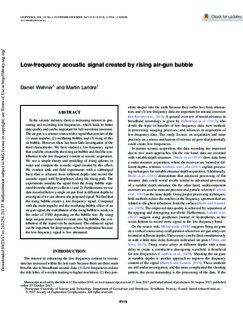| dc.contributor.author | Wehner, Daniel | |
| dc.contributor.author | Landrø, Martin | |
| dc.date.accessioned | 2018-01-19T08:56:54Z | |
| dc.date.available | 2018-01-19T08:56:54Z | |
| dc.date.created | 2017-10-23T19:21:25Z | |
| dc.date.issued | 2017 | |
| dc.identifier.citation | Geophysics. 2017, 82 (6), P119-P128. | nb_NO |
| dc.identifier.issn | 0016-8033 | |
| dc.identifier.uri | http://hdl.handle.net/11250/2478293 | |
| dc.description.abstract | In the seismic industry, there is increasing interest in generating and recording low frequencies, which leads to better data quality and can be important for full-waveform inversion. The air gun is a seismic source with a signal that consists of the (1) main impulse, (2) oscillating bubble, and (3) rising of this air bubble. However, there has been little investigation of the third characteristic. We have studied a low-frequency signal that could be created by the rising air bubble and find the contribution to the low-frequency content in seismic acquisition. We use a simple theory and modeling of rising spheres in water and compute the acoustic signal created by this effect. We conduct tank and field experiments with a submerged buoy that is released from different depths and record the acoustic signal with hydrophones along the rising path. The experiments simulate the signal from the rising bubble separated from the other two effects (1 and 2). Furthermore, we use data recorded below a single air gun fired at different depths to investigate if we can observe the proposed signal. We find that the rising bubble creates a low-frequency signal. Compared with the main impulse and the oscillating bubble effect of an air-gun signal, the contribution of the rising bubble is weak, on the order of 1/900 depending on the bubble size. By using large air-gun arrays tuned to create one big bubble, the contribution of the signal can be increased. The enhanced signal can be important for deep targets or basin exploration because the low-frequency signal is less attenuated. | nb_NO |
| dc.language.iso | eng | nb_NO |
| dc.publisher | Society of Exploration Geophysicists | nb_NO |
| dc.title | Low-frequency acoustic signal created by rising air-gun bubble | nb_NO |
| dc.type | Journal article | nb_NO |
| dc.type | Peer reviewed | nb_NO |
| dc.description.version | publishedVersion | nb_NO |
| dc.source.pagenumber | P119-P128 | nb_NO |
| dc.source.volume | 82 | nb_NO |
| dc.source.journal | Geophysics | nb_NO |
| dc.source.issue | 6 | nb_NO |
| dc.identifier.doi | 10.1190/geo2016-0674.1 | |
| dc.identifier.cristin | 1507024 | |
| dc.relation.project | EC/H2020/641943 | nb_NO |
| dc.relation.project | Norges forskningsråd: 228400 | nb_NO |
| dc.description.localcode | © Society of Exploration Geophysicists 2017 | nb_NO |
| cristin.unitcode | 194,64,90,0 | |
| cristin.unitname | Institutt for geovitenskap og petroleum | |
| cristin.ispublished | true | |
| cristin.fulltext | preprint | |
| cristin.qualitycode | 2 | |
